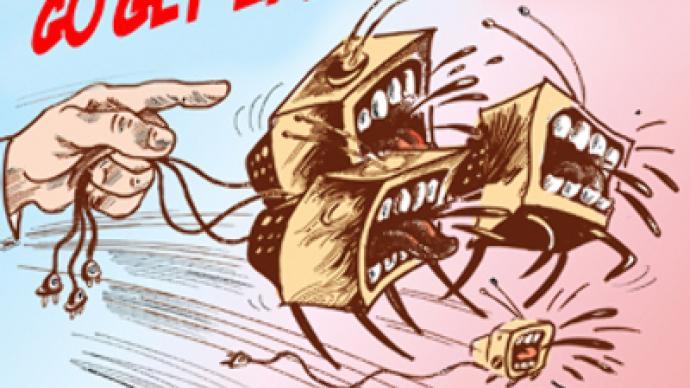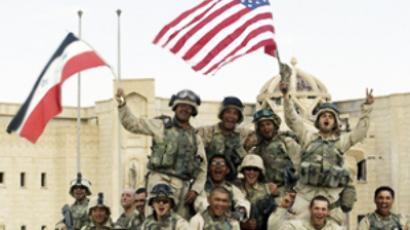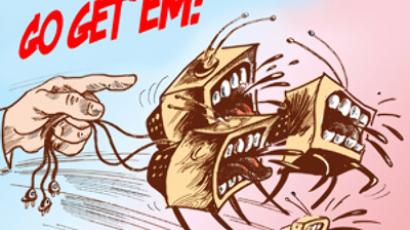Spin-a-war. War on Terror as a spin of the imagination. Part 2: Illusions

Illusions caused by emotions – and by TV broadcasts
The war on terror is a maze of magic mirrors creating perfect optical and mental illusions. It has been that way since Day One, or 9/11 as we came to call it. On that day we first heard that America is at war. Or rather – we read it on the CNN screen. Or on the Fox screen. Every US and international TV channel came up with “America at war” sooner or later on that shocking day.
Emotions moved in waves on September 11, 2001. I remember driving along a street in Bangkok when a Thai friend called and asked if I had seen a plane crash into one of the Twin Towers. It’s live on CNN! I thought at first it was a movie, he shouts in my ear. Many, on the first go, thought they had hit HBO instead of CNN.
I rushed to the nearest spot with a big TV: the Foreign Correspondents Club of Thailand, right on time to see the second airplane hit. No doubts after that: America is under a terrorist attack. A slogan to that effect appears on the screen without delay. My next thought is of that Tom Clancy novel “The Sum of All Fears”, in which a mentally unstable Japanese airline pilot fills up his Boeing with fuel, takes off without passengers or cargo, just with a co-pilot he uses for the take-off and kills later with an apology, and plunges his makeshift kamikaze weapon into the top of the Capitol Hill.
My thought of Clancy is half a minute old when I hear an expert on Fox saying it aloud – and the next minute Tom Clancy himself is there, in some other channel’s studio, being asked stupid questions about his gift of foresight. On another channel someone remembers that the Chechen terrorist Shamil Basayev once threatened to hijack a civilian liner and crash it into the Kremlin in Moscow…
The French president at the time said “On this day we are all Americans” – and it indeed was the sentiment felt by most of those who were watching the tragedy live on TV. But it was also the first illusion of the War on Terror: the TV gave us all an illusion of being part of it, of being “us” against “them” – those who sent the planes to crash into the WTC. The feelings we had were absolutely real and well-justified, while the image of the enemy that was being drawn in our minds throughout the live broadcast and for days and months after it, had very little to do with the reality.
Illusions of the eye and illusions of the mind
In reality the attack was very precisely aimed at the symbols of America’s financial and military power. The terrorists were not “attacking America’s freedom” at all, they were attacking America’s financial establishment (blaming it for its avaricious behavior and control of the world economy through the US dollar, as well as for its undying support of Israel) and the Pentagon (blaming it for its military actions abroad and its constant presence in the Middle East, plus the usual: supporting Israel). They were attacking the main vehicles of America’s hegemonic intentions. No one drove a plane into the Statue of Liberty.
Of course, the WTC was also chosen for the effect: the more people die in one attack, and the more exclusive TV footage the attack produces, the better it is for the terrorist masterminds. That attack was designed and engineered for live television, and that is the only reason why so many people had to die… That is no reason at all, for me as well as for our reader, but that is the way those inhuman minds think. The inhuman minds of a tiny group of determined, self-created automatons of their own, self-proclaimed “Holy War”.
Which brings us to one more illusion: that the attack in New York reflected the mindset, the cause and the intent of a whole community of radicals who share the same goals in the same Jihad all over the world: Islamic terrorists. Meaning Al Qaeda plus the Taliban plus Saddam Hussein (how has this guy got involved, I wonder), Iran, Hezbollah, HAMAS, Abu Sayaf, and others. Luckily, such illusions like this one are short-lived, they cannot survive longer than one administration does. Thank God president Obama has just rejected and dissolved this illusion with his speech in Cairo. Or has he indeed?
Illusions of intelligence
Another frame from the first days: America enraged! The overall sentiment is: “Let’s hit the bastards! Let’s hit them bad!” Then America hits. If you shut your eyes on the TV screen and protect your ears from the song of the “embedded” TV correspondents, you start seeing it clearly as it is: America, like a huge blundering troll, hitting with its giant club the heads, shoulders and spines of the wrong people: the Afghan civilians instead of the Taliban and Iraqi hospitals instead of military headquarters. One in a few blows hits the intended target, and that creates another illusion: that of precision tactics.
Precision weapons more or less proved that they are indeed considerably precise in Yugoslavia, 1999 (there were lots of collateral damage, though, too). But their precision remains an illusion for the simple fact that to launch a precision weapon you need to know precisely where the target is. That is a human factor, and it often misfires. The intelligence on the target may be delivered by a satellite or an unpiloted aircraft, but the evaluation is always done by a human being prone to human error. Especially in a war in unfamiliar terrain, and especially when some daytime local farmers (not all, but who knows which?) turn enemy combatants at night, and when you never know from which direction the next enemy attack may originate.
One more illusion, of which a lot was said after September 11: the might of the US intelligence community and its army of intelligence-gathering technical devices and gadgets, from satellites to motion sensors dropped from aircraft, to stay indefinitely long in enemy territory, reporting motion and many things beyond. In the open media you will find reports of such devices recognizing enemy troops and reporting their movements in the open by the chemical composition of their sweat, urine and feces (provided “the good guys” know what kind of rations are fed to these troops).
It appears that all that paraphernalia is worthless in Afghanistan and Iraq without being complemented by good quality human intelligence. And that is exactly what the US lacked in the late 1990s–early 2000s in the Middle East, Central Asia and other important parts of the world. American media, as well as some academics, say that US human intelligence networks, severely decimated in times of supremacy of technical means of intelligence gathering, were in the early stages of rebuilding when the WTC was hit.
That is why the initial Allied victory over the Taliban would have been impossible without Russian “consultants” – officers with combat experience from the Soviet war in Afghanistan, attached to the American and NATO units in 2001–2002. They knew the terrain and typical behavior of the enemy. After the Taliban government was overthrown, they returned to their duties in Russia.
The illusion of the century, or What to do with the flies in your soup?
And now to the biggest illusions of all in the whole War on Terror and maybe in the history of the 20th and 21st centuries: the illusion of victory and the illusion of democracy. It has already happened twice in a row. The victory in Afghanistan was complete and fast: the Taliban overthrown, a new democratic government installed, now the sky was the limit for freedom and democracy in Central Asia.
Alas, not even years but months after the victory the country slip-slided into chaos and then for years after, the best minds of the world combined efforts to find a solution. And they found none – at least none so far.
In Iraq the victory lived a bit longer, but nevertheless the situation deteriorated into a colorful chaotic movement of particles of every shade of religion, ethnicity and language, all armed to the teeth. US and allied troops are locked up in their fortresses and venture out only to perform a combat operation and return under cover. That is perfect soil for a growing young democracy, isn’t it?
Eight years of the War on Terror have shown one thing clearly: the idea that by regime change and nation-building (meaning the proliferation of democracy) it is possible to overcome terrorism is a dangerous illusion. Yes, terrorism exists as long as poverty and suffering exist, as long as lawlessness and corruption exist, as long as the world is unfair.
All these factors feed terrorism, but they are not reasons for its emergence and existence!
All these factors are best fought with development, good governance and democracy, but that doesn’t exclude the existence of terrorism!
Terrorism exists because there are people, very few, who believe that by using terrorist methods they can make the wrongs of the world right. That is their illusion – in fact, good can be made out of evil, but happiness and life cannot be made from suffering and death. Their beliefs represent an abomination of general human values, common to the majority of mankind. And in society (and History is witness to this) the most effective way to rid the world of an abomination has always been to form a small group of professionals that learns all that can be learnt about the abomination, finds its weak spots, and strikes to kill.
Democracy itself is no cure for terrorism. Terrorism can exist in a democracy: isn’t it a fact that most of the known terrorist organizations are based in democracies? A democracy has a developed legal system which the terrorists can use to their advantage if caught. What has the US been pursuing in both Iraq and Afghanistan? The proliferation of democracy, or a defeat of terrorism? Both would be the most feasible answer: some people at the top thought that bringing democracy to the two nations would facilitate the defeat of terrorism there. A beautiful concept – but illusory.
We say in Russia: if there’s a fly in your soup, it is better to separate the two before you start eating. You see? There may be folks who eat flies – they say insects are pure protein and good for you. Not me, and not you probably. But there may be. And even for those folks the advice is to eat their soup separately from their flies – because the two just don’t go together well. The same happens when anti-terrorism meets proliferation of democracy. They are so different that mixing them is known to have led to unpredictable negative consequences.
Just like the mess in Afghanistan and Iraq that the US (and the rest of the civilized world together with it) will have to start cleaning up in the nearest future…
Evgeny Belenkiy, RT.














